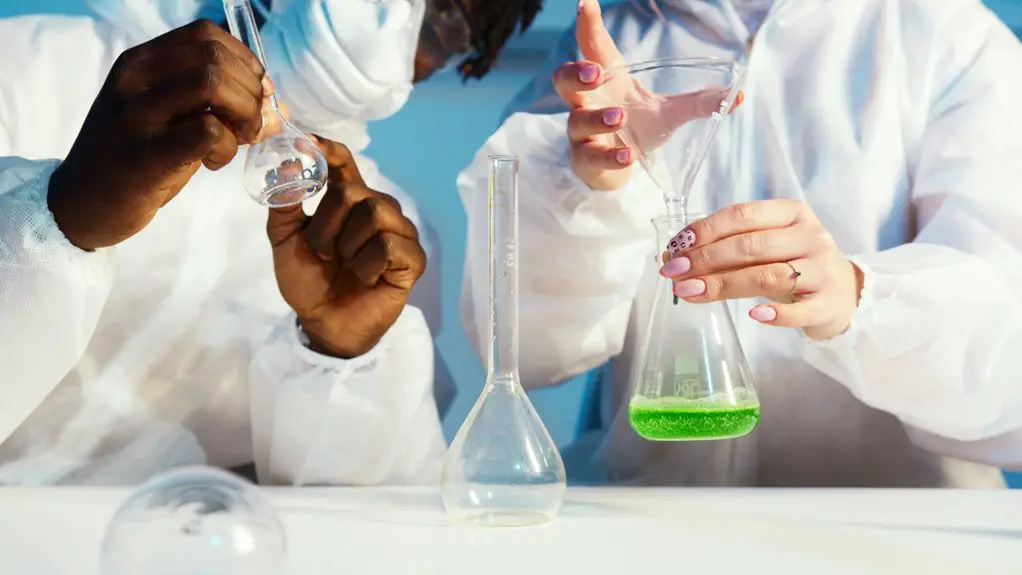You’re exposed to hazards every day, you’re surrounded by toxic chemicals, and you’re at risk of long-term health issues. Whether you’re a worker handling dyes or a wearer unaware of hidden dangers, the health impacts are significant. The consequences of this exposure can be dire, affecting not just your body but also your quality of life. What can be done to guarantee safety for both workers and consumers in the textile industry?
Table of Contents
Key Takeaways
- Workers exposed to textile chemicals face increased risks of skin irritations, respiratory issues, and long-term health consequences like cancer.
- Prolonged contact with harmful dyes and solvents can disrupt hormonal balance and reproductive health for both workers and consumers.
- Contaminated clothing can leach toxic substances into the body, affecting wearers’ health over time.
- Poor ventilation in workplaces exacerbates chemical exposure, heightening the risk of chronic respiratory conditions among workers.
- Awareness and advocacy for safer alternatives can mitigate health risks linked to textile chemicals for both workers and consumers.
Occupational Risks Faced by Textile Workers
While you might think of the vibrant fabrics and stylish clothing we wear, the reality for textile workers often involves significant occupational risks.
Working in factories, you face exposure to heavy machinery, which can lead to accidents and injuries. The environment can be filled with noise, increasing the risk of hearing loss over time.
Exposure to heavy machinery and high noise levels in factories significantly heightens the risk of accidents and long-term hearing loss.
Additionally, standing for long hours can cause musculoskeletal disorders. You might also deal with high temperatures and poor ventilation, making work uncomfortable and potentially harmful.
Furthermore, the repetitive nature of tasks can lead to strain injuries. All these factors create a challenging work environment, emphasizing the need for improved safety measures and regulations to protect textile workers from these hazards.
Health Issues Linked to Chemical Exposure
Beyond the physical dangers of machinery and long hours, chemical exposure in the textile industry poses severe health risks. You might experience skin irritations, rashes, or more serious conditions like dermatitis due to contact with dyes and solvents.
Prolonged exposure to these substances can lead to chronic health issues, including reproductive problems and hormone disruptions. You could also face heightened risks of certain cancers, depending on the chemicals you’re regularly exposed to.
Even if you’re a consumer, wearing clothing treated with hazardous substances can affect your health. It’s essential to be aware of the potential dangers linked to these chemicals, whether you’re working directly with them or simply wearing the finished products.
Prioritizing safety and awareness can help mitigate these health risks.
Respiratory and Musculoskeletal Disorders
As you navigate the textile industry, you may encounter respiratory and musculoskeletal disorders that can considerably impact your health. Breathing in toxic chemicals and dust particles can lead to conditions like asthma or chronic bronchitis. Additionally, repetitive motions and poor ergonomic practices can result in musculoskeletal issues, such as carpal tunnel syndrome or chronic back pain. It is crucial to recognize these risks and take preventive measures.
| Disorder Type | Description |
|---|---|
| Respiratory Disorders | Conditions caused by inhaling harmful substances |
| Musculoskeletal Disorders | Injuries from repetitive strain or poor posture |
| Symptoms | Coughing, wheezing, fatigue |
| Prevention | Use protective gear, maintain proper ergonomics |
Psychological Effects of Working Conditions
Working in the textile industry can take a toll on your mental well-being due to the often high-pressure environment and exposure to hazardous conditions.
You might feel constant stress from tight deadlines and the demands of efficiency, which can lead to anxiety and burnout. The repetitive nature of tasks can also contribute to feelings of monotony and dissatisfaction.
Additionally, working in unsafe environments may leave you feeling helpless, further impacting your mental state. Poor communication and lack of support from management can exacerbate these issues, leading to a sense of isolation.
It’s essential to recognize these psychological effects and seek support, whether through counseling or peer networks, to maintain your mental health while maneuvering this challenging industry.
Cancer Risks Associated With Textile Chemicals
The challenges of the textile industry extend beyond mental strain; they also encompass serious health risks, particularly concerning cancer.
Exposure to hazardous chemicals like azo dyes, formaldehyde, and carcinogenic solvents during manufacturing can greatly increase your cancer risk. These substances may linger in the air or on your skin, heightening your vulnerability.
Workers often face prolonged exposure without adequate protective measures, leading to potential long-term health consequences.
Even after the manufacturing process, these chemicals can affect you through skin absorption or inhalation.
It’s essential to recognize the importance of regulations and safety protocols in mitigating these risks.
Impact of Chemical Residues on Consumers
When you wear clothing treated with harsh chemicals, you might experience skin allergies and irritation.
Over time, these residues can lead to more serious long-term health risks.
It’s crucial to understand where these chemical contaminants come from and how they affect your well-being.
Skin Allergies and Irritation
Although you might not see them, chemical residues from textiles can lead to significant skin allergies and irritations. You may experience redness, itching, or rashes after wearing certain clothing. It’s essential to understand how these residues can affect your skin. Here’s a quick overview of common irritants:
| Irritant | Symptoms |
|---|---|
| Formaldehyde | Itching, redness |
| Azo dyes | Skin rashes, dermatitis |
| Heavy metals | Eczema, irritation |
| Phthalates | Allergic reactions |
Taking precautions by choosing organic or low-chemical fabrics can minimize these risks. Always wash new clothes before wearing them to help reduce potential irritants. Your skin deserves the best care!
Long-term Health Risks
Skin irritations from textile chemicals are just the tip of the iceberg. Long-term exposure to these chemical residues can lead to serious health risks for consumers.
You mightn’t realize that wearing clothes treated with harmful substances could increase your chances of developing respiratory issues, hormonal imbalances, and even reproductive problems. Some toxic chemicals can accumulate in your body over time, making them harder to eliminate.
You’re also at risk of experiencing chronic skin conditions or more severe health disorders. By choosing clothing made from organic or sustainably sourced materials, you can reduce your exposure to these dangerous residues.
It’s essential to be aware of the potential long-term effects on your health and make informed choices about what you wear.
Chemical Contamination Sources
While you may think your clothing is safe, chemical contamination sources are often hidden in plain sight. Many fabrics are treated with pesticides, dyes, and finishing agents that can linger long after production. When you wear these clothes, you might absorb harmful residues through your skin.
Even washing can release microplastics and chemicals into the water supply, impacting both your health and the environment. Additionally, second-hand clothing can carry unknown contaminants, making it essential to be cautious about where you shop.
To protect yourself, opt for organic or eco-friendly brands that prioritize safety and transparency. By being mindful of your clothing choices, you can reduce your exposure to these hidden dangers and promote a healthier lifestyle.
The Role of Toxic Dyes in Health Risks
Toxic dyes, frequently used in the textile industry, pose significant health risks that you mightn’t be aware of.
When you wear garments dyed with these chemicals, you could experience skin irritations, allergic reactions, or even respiratory issues. Prolonged exposure to toxic dyes can lead to more severe health problems, such as hormone disruption and increased cancer risks.
If you’re working in the industry, you might be exposed to harmful fumes and skin contact during the dyeing process, putting your health at risk.
It’s crucial to be aware of the products you choose and the potential dangers they carry. By opting for safer, eco-friendly alternatives, you can protect yourself from the harmful effects of toxic dyes while promoting a healthier textile industry.
Environmental Contamination From Textile Chemicals
Textile chemicals don’t just affect your health; they also wreak havoc on the environment.
When these substances run off into water systems, they can degrade water quality and harm local ecosystems.
You mightn’t realize it, but the impact of these chemicals stretches far beyond the factory floor.
Chemical Runoff Consequences
As industrial processes release chemicals into waterways, the consequences of chemical runoff from textile production become increasingly alarming.
You may not realize that these chemicals can contaminate local ecosystems, harming aquatic life and disrupting food chains. Fish and other marine organisms absorb toxic substances, which can eventually make their way back to you through the food supply.
Additionally, polluted water can affect communities relying on these sources for drinking and irrigation. The long-term impacts aren’t just environmental; they pose significant health risks to those who consume contaminated seafood or use tainted water for agriculture.
Water Quality Degradation
While many may overlook the impact of industrial practices, water quality degradation from textile chemicals poses a serious threat to our ecosystems and health.
When you wear clothing made from chemically treated fabrics, you mightn’t realize that these substances can leach into local water sources during production and disposal. Chemicals like dyes and solvents can contaminate rivers and lakes, affecting drinking water and aquatic life.
This pollution compromises not just the environment, but also your health, as contaminated water can lead to serious illnesses.
Ecosystem Health Risks
The health of ecosystems is at risk due to the contamination caused by chemicals used in fabric production. When you wash your clothes, these harmful substances often enter waterways, disrupting aquatic life.
Fish and other organisms absorb these toxins, leading to weakened populations and biodiversity loss. You mightn’t realize that the pesticides and dyes used in textiles can also seep into soil, affecting plant growth and soil health.
This contamination can reduce crop yields, threatening food security. Additionally, as ecosystems become imbalanced, you may notice changes in local wildlife, including diminished species and altered habitats.
Understanding these risks helps you make informed choices about your clothing and encourages more sustainable practices within the textile industry.
Mitigation Strategies for Worker Safety
To safeguard workers from the harmful effects of textile chemicals, it is vital to implement effective mitigation strategies. Start by enhancing ventilation systems in workspaces to reduce chemical exposure. Providing personal protective equipment (PPE) is also important; make certain that workers are trained to use it correctly. Regular monitoring of air quality can help identify hazardous levels of chemicals early. Finally, fostering a culture of safety through training programs empowers workers to recognize risks and take proactive measures.
| Strategy | Description |
|---|---|
| Ventilation Improvements | Enhance airflow to dilute chemical exposure |
| PPE Provision | Supply appropriate gear for protection |
| Air Quality Monitoring | Regularly check for hazardous substances |
| Safety Training | Educate workers on risks and safe practices |
Future Research Directions in Textile Health Studies
As you explore future research directions in textile health studies, consider the long-term effects of chemical exposure on workers and consumers alike.
Identifying safer chemical alternatives is essential for creating a healthier industry.
Long-term Health Effects
While many studies have focused on the immediate effects of textile chemicals, understanding long-term health impacts remains vital for thorough insights into public health.
You might be surprised to learn that chronic exposure to these chemicals can lead to various health issues, including respiratory problems, skin conditions, and even more serious diseases like cancer.
Investigating the cumulative effects of these substances over time is essential, as they can accumulate in your body and disrupt endocrine functions.
Future research should prioritize longitudinal studies that track these health outcomes in workers and wearers alike.
Safer Chemical Alternatives
Finding safer chemical alternatives in the textile industry is essential for protecting both public health and the environment. You’ll want to explore biodegradable materials, natural dyes, and non-toxic finishes that can replace harmful substances.
Research into plant-based fibers and low-impact dyes is gaining momentum, offering promising options that minimize health risks for workers and consumers alike. Collaborations between scientists, manufacturers, and regulatory bodies can accelerate the development of these alternatives.
You should also advocate for transparency in chemical usage, pushing brands to disclose their ingredients. By choosing safer chemicals, you’re not just benefiting yourself; you’re contributing to a healthier planet and better working conditions for textile workers.
Embracing these innovations could lead to a sustainable future for the industry.
Frequently Asked Questions
How Can Consumers Identify Safe Textile Products?
Wondering how to find safe textile products? Start by checking labels for certifications, researching brands’ practices, and opting for natural fibers. You’ll feel more confident about your choices and protect yourself from potential hazards.
What Regulations Exist for Textile Chemical Safety?
You’ll find various regulations for textile chemical safety, including the REACH regulation in Europe and the Consumer Product Safety Improvement Act in the U.S. These laws aim to limit hazardous substances in textile products for better consumer protection.
Are There Eco-Friendly Alternatives to Toxic Textile Chemicals?
Imagine a garden blooming with vibrant colors, free from harmful pesticides. You can explore eco-friendly alternatives like natural dyes, organic cotton, and plant-based treatments, allowing your creations to flourish while protecting both the planet and your health.
How Does Textile Chemical Exposure Affect Productivity?
Exposure to textile chemicals can greatly reduce your productivity. You might experience fatigue, headaches, or respiratory issues, making it difficult to focus and perform tasks efficiently. Staying healthy helps you maintain ideal performance and productivity levels.
What Steps Can Be Taken to Promote Consumer Awareness?
You can channel your inner Sherlock Holmes by investigating brands’ practices. Share your findings on social media, support transparency, and encourage others to seek safer products. Together, you can create a more informed, conscious consumer community.
- Tetron Fabric for Marine Applications: Durability and Use Cases - June 18, 2025
- Tetron Fabric for Outdoor Furniture: Weather Resistance and Care - June 18, 2025
- Tetron Fabric for Wall Coverings: Style and Application Tips - June 18, 2025





